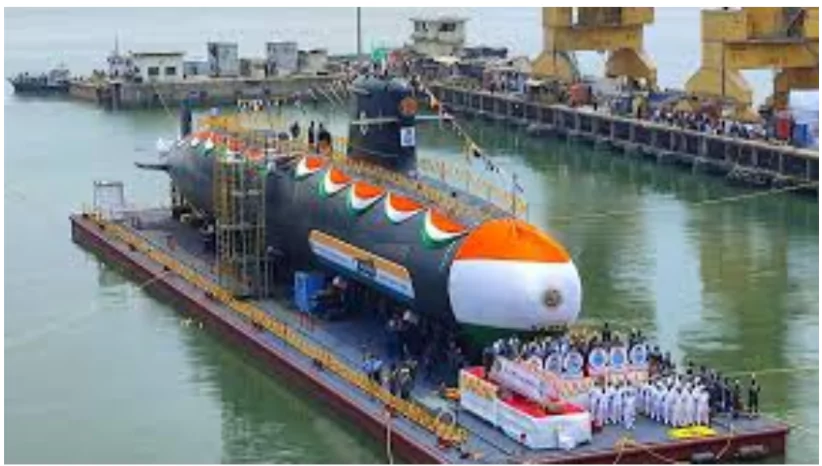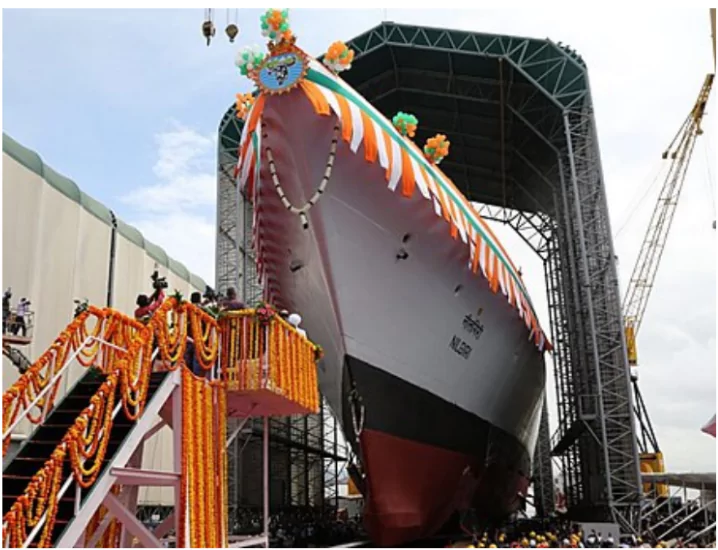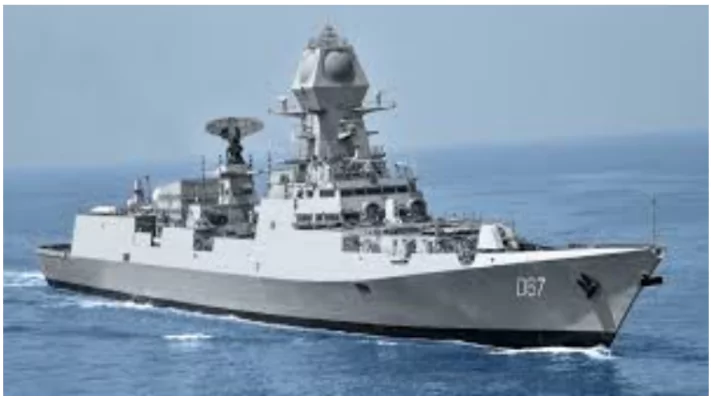The Indian Navy commissioned three frontline platforms into service at the Naval Dockyard, Mumbai recently.
- The commissioned ships are,
-
- Vagsheer: The sixth and last Scorpene-class submarine; Surat: The fourth and last of the Project-15B stealth destroyers; Nilgiri: The lead ship of the Project-17A stealth frigates
About the 3 Platforms
- Vagsheer:
- It is the last of the six Kalvari class Project 75 Scorpene class submarine
 Built By: The submarine is entirely built by the Indian shipyard Mazagon Dock Shipbuilders Limited (MDL) through technology transfer and partnership with France’s Naval Group.
Built By: The submarine is entirely built by the Indian shipyard Mazagon Dock Shipbuilders Limited (MDL) through technology transfer and partnership with France’s Naval Group.- Features:
- It is a silent and versatile diesel-electric submarine.
- Technology: It features modular construction which allows for future upgrades such as the integration of Air Independent Propulsion (AIP) technology.
- Range of Missions: The Submarine can conduct anti-surface warfare, anti-submarine warfare, intelligence gathering, area surveillance, and special operations.
- Weapons: It is armed with wire-guided torpedoes, anti-ship missiles, and advanced sonar systems
Enroll now for UPSC Online Classes
- Nilgiri:
- It is the lead ship of Project-17A guided stealth frigates and is a major advancement over the Shivalik-class frigate
 Built by: The ship is built by the Indian shipyard Mazagon Dock Shipbuilders Limited (MDL) and is designed indigenously by the Indian Navy’s Warship Design Bureau
Built by: The ship is built by the Indian shipyard Mazagon Dock Shipbuilders Limited (MDL) and is designed indigenously by the Indian Navy’s Warship Design Bureau- Features:
- Stealth: The platform incorporates significant stealth features and reduced radar signatures through state-of-the-art technology.
- Multi Role Platform: Nilgiri is a multi-role asset prepared to counter any surface, sub-surface, or air threat.
- The ship possess advanced sensors and the capability to operate a variety of helicopters including the MH-60R during both day and night operations.
- Operation: Rail-Less Helicopter Traversing System and a Visual Aid and Landing System ensure seamless operations under all conditions.
- Surat:
- It is the 4th ship of the Visakhapatnam Class Project-15B and is a stealth destroyer
- Visakhapatnam Class Project-15B is the follow-on class to the Kolkata-class (Project-15A) destroyers.
 Predecessors: INS Visakhapatnam (commissioned in 2021), INS Mormugao (2022) and INS Imphal (2023)
Predecessors: INS Visakhapatnam (commissioned in 2021), INS Mormugao (2022) and INS Imphal (2023)- Built By: The ship is built by the Indian shipyard Mazagon Dock Shipbuilders Limited (MDL) and is designed indigenously by the Indian Navy’s Warship Design Bureau
- Features:
- Surat is the first naval ship to be named after a city in Gujarat
- Surat is the first Artificial Intelligence (AI) enabled warship utilising indigenously developed Al solutions enhancing its operational efficiency.
- Weapons: It is equipped with state-of-the-art weapons and sensors, including surface-to-air missiles, anti-ship missiles and torpedoes.
- Powered By: Surat is powered by a combined gas and gas (COGAG) propulsion set, comprising four gas turbines.
Project 15B
- It is also known as the Visakhapatnam-class destroyers, is a series of guided-missile warships being built for the Indian Navy
- The ships are an advanced version of the Kolkata-class destroyers with improved stealth, automation, and armament capabilities.
- Series of Ships: It has 4 ships with the lead ship of the class, INS Visakhapatnam already being commissioned in November 2021.
- The second ship, INS Mormugao and 3rd ship INS Imphal have already been commissioned.
- Design: They have a sleek hull design, radar-transparent deck fittings, and a total atmospheric control system to protect the crew.
- Features: The ships have multiple fire zones, battle damage control systems, and distributional power systems. They also have an enclosed helicopter hangar and flight deck that can accommodate two multi-role helicopters
Project 75
- Also called the Scorpene class submarines it is a joint venture between the Naval Group of France and Mazagon Dock Limited (MDL) to build six advanced diesel electric conventional submarines for the Indian Navy
- Submarines Under Project 75: INS Kalvari, INS Vagsheer, INS Vela, , INS Khanderi, INS Karanj, and INS Vagir.
- Features: Improved acoustic absorption techniques; Low radiated noise levels; Long-range guided torpedoes; Tube-launched anti-ship missiles; Sonars and sensor suites
Project 17A
- It is a series of stealth guided-missile frigates being built for the Indian Navy.
- Designed: The frigates are designed by the Indian Navy’s Warship Design Bureau and are being built by Mazagon Dock Shipbuilders Limited (MDL) and Garden Reach Shipbuilders & Engineers (GRSE)
- Series of Ships: The ships are named on mountain ranges of India like,
- Nilgiri, Udaygiri, Taragiri, Mahendragiri, Himgiri, Dunagiri, and Vindhyagiri.
- Equipments: The frigates is equipped with advanced weapons, sensors, and platform-management systems. They also have a Rail-Less Helicopter Traversing System and a Visual Aid and Landing System.
|
Check Out UPSC NCERT Textbooks From PW Store
Air Independent Propulsion
- It is a marine propulsion technology that increases the stealth and endurance of a non-nuclear submarine to operate without access to atmospheric oxygen (by surfacing or using a snorkel)
- Indigenous AIP technology: Fuel Cell-based Air Independent Propulsion (AIP) system of DRDO’s Naval Materials Research Laboratory (NMRL) will soon be fitted onboard INS Kalvari.
- Significance:
-
- Endurance: An AIP module acts as a force multiplier as it enables conventional submarines to remain submerged for longer duration thereby increasing their endurance and reducing chances of detection.
- Upgrade: AIP can be retrofitted into existing submarine hulls by inserting an additional hull section.
|
![]() 2 Jan 2025
2 Jan 2025

 Built By: The submarine is entirely built by the Indian shipyard Mazagon Dock Shipbuilders Limited (MDL) through technology transfer and partnership with France’s Naval Group.
Built By: The submarine is entirely built by the Indian shipyard Mazagon Dock Shipbuilders Limited (MDL) through technology transfer and partnership with France’s Naval Group. Built by: The ship is built by the Indian shipyard Mazagon Dock Shipbuilders Limited (MDL) and is designed indigenously by the Indian Navy’s Warship Design Bureau
Built by: The ship is built by the Indian shipyard Mazagon Dock Shipbuilders Limited (MDL) and is designed indigenously by the Indian Navy’s Warship Design Bureau Predecessors: INS Visakhapatnam (commissioned in 2021), INS Mormugao (2022) and INS Imphal (2023)
Predecessors: INS Visakhapatnam (commissioned in 2021), INS Mormugao (2022) and INS Imphal (2023)